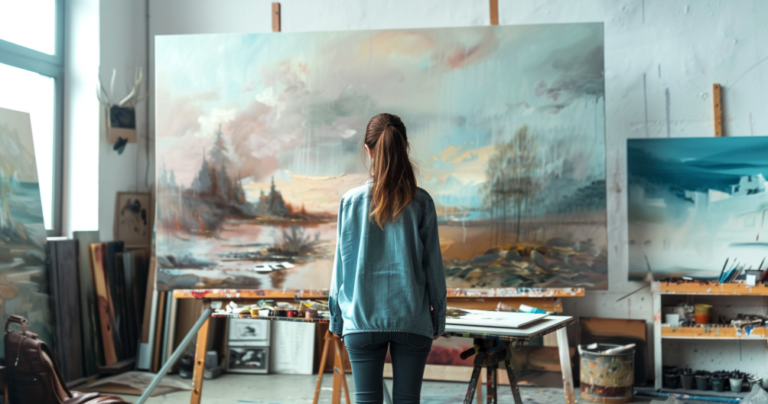Creating your plaster art on canvas is a fantastic way to add a personalized touch to your home decor. You’ll need some plaster or joint compound, a canvas, and a few essential tools like a putty knife or spatula. These simple materials can help you achieve a stunning, textured finish that looks elegant and modern.
The process is straightforward and doesn’t require any prior artistic experience. Could you spread the plaster evenly across the canvas in a chosen pattern? Let your project dry on a flat, shaded surface to prevent cracking. This patience pays off with a piece that’s uniquely yours.
How to Make Plaster Art on Canvas
Whether you are refreshing an old painting or starting with a blank canvas, plaster art allows for endless creativity. Dive into this fun DIY project and see how easy it is to turn your artistic vision into reality.
Gathering Your Materials

Choosing the Right Canvas
When selecting a canvas for your plaster art, size and type are crucial. Opt for a sturdy, high-quality canvas as it needs to hold the weight of the plaster without sagging. Pre-stretched, cotton or linen canvases work well. Ensure the frame is well-built to support your plaster layers.
Consider the size depending on your artistic vision. Smaller canvases are easier to work with for beginners. Make sure the canvas is primed, which means it has been pre-treated with gesso, allowing the plaster to adhere effectively.
Selecting Plaster
Picking the right plaster can make or break your project. A popular choice is a joint compound, which is both accessible and easy to work with. For textured effects, consider using texture mediums that are specifically designed for art projects.
You can find plaster at most hardware stores, often in pre-mixed tubs. Look for a smooth consistency free from lumps. This will make the application smoother and your artwork more polished. Let’s not forget that drying time is vital. Some types of plaster might take days to dry completely.
Essential Tools and Accessories
Several tools and accessories are vital for plaster art. A bucket for mixing plaster, palette knives for spreading and shaping, and fine-grit sandpaper for smoothing dried plaster are essential.
You’ll also need a paintbrush or a trowel to apply the base coat of acrylic gesso. A spray bottle of water on hand can help manage the plaster’s consistency during application. Don’t forget disposable gloves to keep your hands clean and protected while you work.
Collecting these materials and tools before starting will keep your creative process smooth and enjoyable.
Preparing Your Workspace

Setting Up Your Canvas
Choose a flat, stable surface to work on, such as a large table or an easel. Lay down a drop cloth or old newspapers to protect your workspace from spills and splatters.
If you’re working with a used canvas, paint it white to provide a clean base. Let it dry completely before proceeding. For new canvases, apply a base coat of acrylic gesso to help the plaster adhere better. Make sure this base coat is even and fully dry.
Organizing Your Tools
Arrange your tools and materials within arm’s reach to maintain a smooth workflow. Key items to have on hand include a putty knife, joint compound, sandpaper, and a large brush.
Keep your mixing bowl or container nearby for convenience. Separate your tools based on their use: mixing, application, and finishing. Use a small tray or container to hold smaller items like brushes and sandpaper to keep your workspace tidy.
Safety Precautions
Safety is crucial when working with plaster and joint compounds. Ensure proper ventilation in your workspace by opening windows or using a fan. Wear a dust mask to avoid inhaling fine particles, especially during sanding.
Protect your skin by wearing gloves, and consider safety goggles to shield your eyes from accidental splashes. Keep a damp cloth or paper towels handy for quick cleanups. Always read the safety instructions on your materials to stay informed about specific precautions.
Creating Your Plaster Artwork

Mixing Plaster to the Right Consistency
- Start by mixing your plaster to the right consistency. Choosing a joint compound or a similar plaster mix can work well.
- Pour the plaster powder into a mixing container.
- Gradually add water while stirring constantly to avoid lumps.
- Aim for a smooth, thick paste-like consistency. If it’s too thick, add more water; if too runny, add more plaster.
- Be careful not to mix too quickly, which can introduce air bubbles.
- Once the consistency is right, you are ready to apply.
Applying Plaster to Canvas
Applying the plaster correctly ensures a robust and interesting texture.
- Begin by priming your canvas with an acrylic gesso base coat.
- Next, use a trowel or palette knife to spread the plaster evenly across the canvas.
- To create texture, experiment with different tools like brushes, combs, or even your fingers.
- Gently layer the plaster, avoiding too much pressure that might cause cracks.
- Work quickly, as plaster can start to dry out within minutes.
Incorporating Color and Texture
Adding color and texture to your artwork adds depth and vibrancy.
- Mix acrylic paints into your plaster before application for a subtle, all-over color.
- Alternatively, wait until the plaster is dry and then use paints to enhance textures and patterns.
- For added interest, embed materials like sand, small stones, or fibers into the wet plaster.
- Consider using stencils for intricate designs or patterns.
Drying and Curing Process
Proper drying and curing of your plaster art are crucial for durability.
- Allow the plaster to dry on a flat, shaded surface to prevent cracking. This can take several days.
- Ensure the area is well-ventilated to help with the drying process.
- Once fully dry, you may want to sand the surface for a smoother finish lightly.
- Finally, apply a protective sealant or varnish to preserve your artwork.
- Keep your artwork away from direct sunlight and humidity during this period.
Finishing Touches
Sealing and Protecting Your Art
After your plaster art has dried completely, applying a sealant is a crucial step to protect it. Choose an acrylic sealer, which is effective for both plaster and canvas. Spray or brush it on evenly.
Using a clear, matte varnish creates a professional finish, ensuring no glossy shine. Apply at least two coats for maximum protection. If your artwork will be displayed in a room with high humidity, consider additional protective measures like a moisture-resistant sealant. This helps prevent cracking and ensures your artwork remains in good condition over time.
Framing and Displaying
Selecting the right frame can elevate your plaster art. Opt for a sturdy wooden frame that complements the texture. Neutral frames like white or natural wood are versatile and do not overshadow your artwork.
Ensure your canvas fits snugly within the frame without any gaps. For a minimalist look, consider a floating frame which gives the illusion of the canvas hovering within the frame. Display your framed art in a well-lit area, but avoid direct sunlight to prevent any damage over time. Proper framing and placement highlight your hard work and enhance its overall aesthetic appeal.
Frequently Asked Questions – How to Make Plaster Art on Canvas
What supplies are needed for beginners to start making plaster art on canvas?
You’ll need a blank canvas, joint compound or plaster, a putty knife, and a drop cloth. If you add color to your artwork, you might want to have paints and brushes. Ensure you have sandpaper for smooth finishes.
What are some creative plaster art ideas for DIY canvas projects?
Try making geometric patterns, floral designs, or abstract textures. Different tools like combs, sponges, and stencils create varied effects. Minimalist designs with smooth, sweeping strokes are also popular and elegant.
How do you properly seal plaster when creating art on canvas?
First, let the plaster dry completely. Then, use a paintbrush to apply a clear acrylic sealer or varnish. Make sure to cover the entire surface evenly. This helps protect your artwork from moisture and dust.






